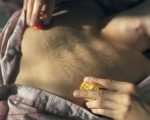Annika Elisabeth von Hausswolff – Ich bin die Ecke aller Räume
Annika Elisabeth von Hausswolff
Annika von Hausswolff first gained public attention in the early 90’s with her highly staged photographs that in their picturesque settings interrogate notions of the body, gender and existing power structures (Back to Nature, 1993). These images are almost documentary in style, with an aesthetic borrowed from photojournalism. The feminine experience is often an underlying element, with notions of ‘womanhood’ as both constraint (The Third Position in Between Two Worlds Where One is Called Infidelity and the Other One Decay, 2004) and masquerade (The First Position in Between Two Worlds Where One is Called Infidelity and the Other One Decay, 2004 and Untitled, 2002). Loneliness and frustration are other recurring themes (Alone by the Window, Late in the Year, 1999 and Alone in the Brown Room, 1999) imbued with feelings of melancholy, longing and sadness. Loss in the sense of absence and memory is evident in amongst others the series Spöke, 2000, and Untitled, 1999 (previously End of Story, where two chairs stand alone in a room). The bed in Where Everything Begins and Ends (1997) and the sofa in Domestic Sculpture (2002) are also devoid of life but bear the traces of recent activity without any further explanation or clues. Freud’s notion of the uncanny [das Unheimliche – literally the un-homely] is visualized in scenes where the familiarity of home is suddenly disrupted and becomes uneasy and strange. The idyll is effectively broken (Girl with Chainsaw, 2002, Stihl, 2004) as disparate elements are brought together to a new, jarring whole. By focusing on individual objects like for example the radiator (Skeleton Object, 2003), the blinds (Untitled, 2003 and Forced Entry by Proxy, 2003) and the sink (Everything is Connected He, He, He, 1999) these everyday objects become estranged before the viewer and turn into abstract shapes, filled with a different, alien meaning. Annika von Hausswolff is also an artist with roots in surrealism’s unpredictability. Guided by Voices (1998) and Study for Sculpture (Leaving this World Behind), 1999 are examples of suggestive works that communicate a vague feeling or atmosphere rather than a narrative or an explicit message. Here the human unconscious and dreams find physical form, and von Hausswolff believes that her works should also function as “platforms for the [viewer’s] projections”. At times the result is hilarious (It Takes a Long Time to Die, 2002), at times poetic (Live from the Ocean, 2005). Perhaps the frequently recurring bubbles can be seen to symbolize existential issues, like a kind of contemporary vanitas motif (Attempting to Deal with Time and Space, 1997). Sometimes the bubbles are inflated to the maximum with the thin membrane threateningly close to bursting – as it seems to have done in Woman with Necksupport (1999) – and sometimes they are obediently manageable (Untitled Bubbles, 2006).
Matter-of-fact representation, the simple and unaffected, is also one of many threads in von Hausswolff’s production. The box (Untitled, 2006) can be seen as an example of this. This process-oriented thinking is also reflected in the exhibition space, where certain works are not hung on the wall but rather lie, still wrapped, on the packing table or lean against a wall.
The new work, a three-dimensional object, is a drapery behind glass (drapes are another recurring theme in Annika von Hausswolff’s work – as a photograph in Now you see it, Now you don’t, 1999, as a physical object in The Memory of My Mother’s Underwear Transformed Into a Flameproof Drape, 2005 and as an installation The Construction of a Breakdown, 2005 at BAC). The glass, promising transparency and complete information, meets with resistance from the mutely pleated blue drapes on the one side and the thick insulation material on the other. There is a door but where it leads is unclear – just like in Alice in Wonderland. The door as subject-matter can also be found in To Carry One’s Door Through the Room from 2003. The surface of the glass as such almost creates the feeling of a photograph, as if the artist works two-dimensionally even when she takes on physical space.
The titles of her pieces are often long and poetic; sometimes they provide clues to an interpretation, sometimes they are as hermetically sealed as the images themselves. This specific hanging of Ich bin die Ecke aller Räume follows neither chronology nor themes and the series have been broken up. As a result there is a new opportunity for reading the work and when explored in a non-linear way new links between works are created.
Annika von Hausswolff was born in1967 and lives and works in Gothenburg. Since the 1990’s she has taken part in many solo and group exhibitions at institutions such as Musée d’Art Moderne de la Ville de Paris; Hasselblad Center, Gothenburg; ARKEN Museum for Moderne Kunst, Copenhagen and Hamburger Bahnhof, Berlin. Her work can be found in collections such as the Guggenheim Museum in New York, Fotomuseum Wintherthur, Switzerland as well as Huis Marseille, Amsterdam. At the 1999 Venice Biennale von Hausswolff represented Sweden at the Nordic Pavilion. At Magasin 3 she has previously been included in the group exhibitions Weegee, Jane & Louise Wilson & Annika von Hausswolff (2000), Extension (2002) and most recently Works from the Collection of Magasin 3 Stockholm Konsthall (2005). Magasin 3 Stockholm Konsthall has supported Annika von Hausswolff’s career for many years and all the works shown in the exhibition are part of the Magasin 3 collection.
An artist’s book will be published in the course of the exhibition including the artist’s own photography of the exhibition space. The book also contains two newly produced texts, the one by the fiction writer John Ajvide Lindqvist and the other by the art historian Malin Hedlin Hayden. A so-called oeuvre section listing the entirety of Annika von Hausswolff’s production will also be included.
Sara Despres
Editor of the publication Ich bin die Ecke aller Räume and substitute curator at Magasin 3.






























































